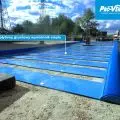The article is from A&B issue 10|23
How should urban ecosystems be created and developed?
Urban ecosystems are an example of the transformation of very diverse natural areas. They are usually highly transformed and degraded ecosystems subjected to anthropopression, isolated from each other and littered. An important conclusion is that urban ecosystems today must be actively protected and new ones created in a highly urbanized environment. Urban greenery today must be multifunctional, and the aestheticization of space and architecture is as important as preserving connections (ecological corridors) between neighboring ecosystems, shaping natural habitats, restoring soil, unsealing pavement, collecting water on site or preventing drainage of neighboring areas.
Nowy Strzeszyn estate in Poznań (design: Insomia)—spontaneously developing meadow-grass sward
photo: Author
A priority task for cities large and small is to secure the remnants of large natural areas—especially „urban sponges,” areas associated with water and capable of retaining it. Land buyouts for future XXL parks accompanying developing neighborhoods should be seen in the category of urgent environmental-adaptive investments in cities, on par with the expansion of roads and streetcar lines, new services or schools. It is necessary to establish new protective areas in cities—ecological uses, natural-landscape complexes—or planning provisions that protect areas with a natural function from development. This is especially true of wetlands, semi-natural meadows or forests, which fit into the tasks of urban adaptation to climate change and do not need to be restored. Many of these areas do not need multimillion-dollar revitalizations, but protection and basic adaptation so that they can perform social functions. Others, such as paved or channelized watercourses, already need expensive restoration processes and their restoration in mapping to natural ecosystems. An interesting solution here is the formation of „sponge cities,” the restoration of urban floodplains on sections of rivers, the removal of concrete fortifications or the establishment of bioretention parks that retain some of the flood waters for a while.
Nowy Strzeszyn estate in Poznań (design: Insomia)—spontaneously developing meadow-grass sward
photo: Author
Developing urban ecosystems also includes active protection by mowing, grazing animals or other agrotechnical treatments. An untapped potential of cities here is the return of livestock to active conservation. The first attempts in Polish cities are already being made, while mobile „live mowers” should become an element of intelligent (smart) urban nature management and concern for the preservation of urban biodiversity. It is worth remembering that simply reducing and delaying the mowing of parts of lawns significantly increases urban biodiversity.
Nowy Strzeszyn estate in Poznań (design: Insomia)—spontaneously developing meadow-grass sward
photo: Author
An important element of shaping urban meadow ecosystems is the elimination of invasive alien species (IGO). These activities should be carried out systematically (for example, by annual mowing) and on a large scale. They should be accompanied by environmental education and raising awareness of what these practices serve. It is necessary to act in favor of native plant species in the arrangement of biologically active areas at school gardens, development of public buildings, in street green belts and new parks.
Nowy Strzeszyn estate in Poznań (design: Insomia)—spontaneously developing meadow-grass sward
photo: Author
In the context of forests, the development of urban ecosystems usually concerns a change in the model of forest management—a shift from a productive and economic function to a protective and educational one. These actions concern the protection of old forests and the provision of appropriate natural elements to increase biodiversity, such as adequate wood biomass for natural decomposition. Actions of reforestation of old fields or landfills are also valuable, also using innovative solutions, such as Akira Miyawaki's micro-forest method.
Nowy Strzeszyn estate in Poznań (design: Insomia)—spontaneously developing meadow-grass sward
photo: Author
The role of the fourth nature, i.e. unmanaged, successional greenery, „urban fallow land” developing on depleted, damaged areas that have lost their socio-economic functions, cannot be overestimated. Many of these areas can serve as so-called natural parks or urban nature parks. Not all such areas need to be revitalized—most often, simple cleanup measures and cooperation with local residents' groups committed to their preservation will suffice. Many areas are quickly renewed in nature, although they are still perceived as „brushwood,” "wasteland,„ or even "Russian self-sown” (sic!). These „new ecosystems” are rapidly evolving into forest over time, and there is no need to interfere with the spontaneous natural processes in them—except for the removal of the most invasive plant species. Ruderal vegetation and „urban weeds” have their own momentous role to play in urban ecosystems, and are highly resistant to drought and heat. Ruderalia should not, as a rule, be eliminated and replaced by ornamental greenery.
Nowy Strzeszyn estate in Poznań (design: Insomia)—spontaneously developing meadow-grass sward
photo: Author
Urban ecosystems are an element of action of various groups and a place of grassroots initiatives of local communities. It is worth appreciating their contribution and involvement in the protection, social care of places with natural functions. This is an underestimated element of civic activity by many Polish city administrators and civil servants. Social capital around nature is a valuable potential, and the energy of social protest can be transformed into sustainable and positive pro-nature activities that residents can identify with and can participate in. Developing urban ecosystems also means properly promoting them and making them accessible to residents. Examples include urban wetland theme parks, eco-parks, educational pavilions or nature trails.
New Strzeszyn estate in Poznań (design: Insomia)—spontaneously developing meadow-grassland sward
photo: Author
Let's remember the micro-scale. A single street tree is also an ecosystem, so it is worth limiting uncontrolled parking on root systems, raking, preventing unwarranted maintenance, replenishing mulch or unsealing the pavement around it. There are more living organisms in a teaspoon of soil than there are humans living on the globe, so it's worth implementing soil-forming solutions at the scale of streets, parks, greens or development greens. Good solutions are composters for leaves and grass swaths, reducing lawn mowing or establishing biocenotic zones.
Nowy Strzeszyn estate in Poznań (design: Insomia)—spontaneously developing meadow-grass sward
Photo: Author
Kasper Jakubowski
photo: Author







































